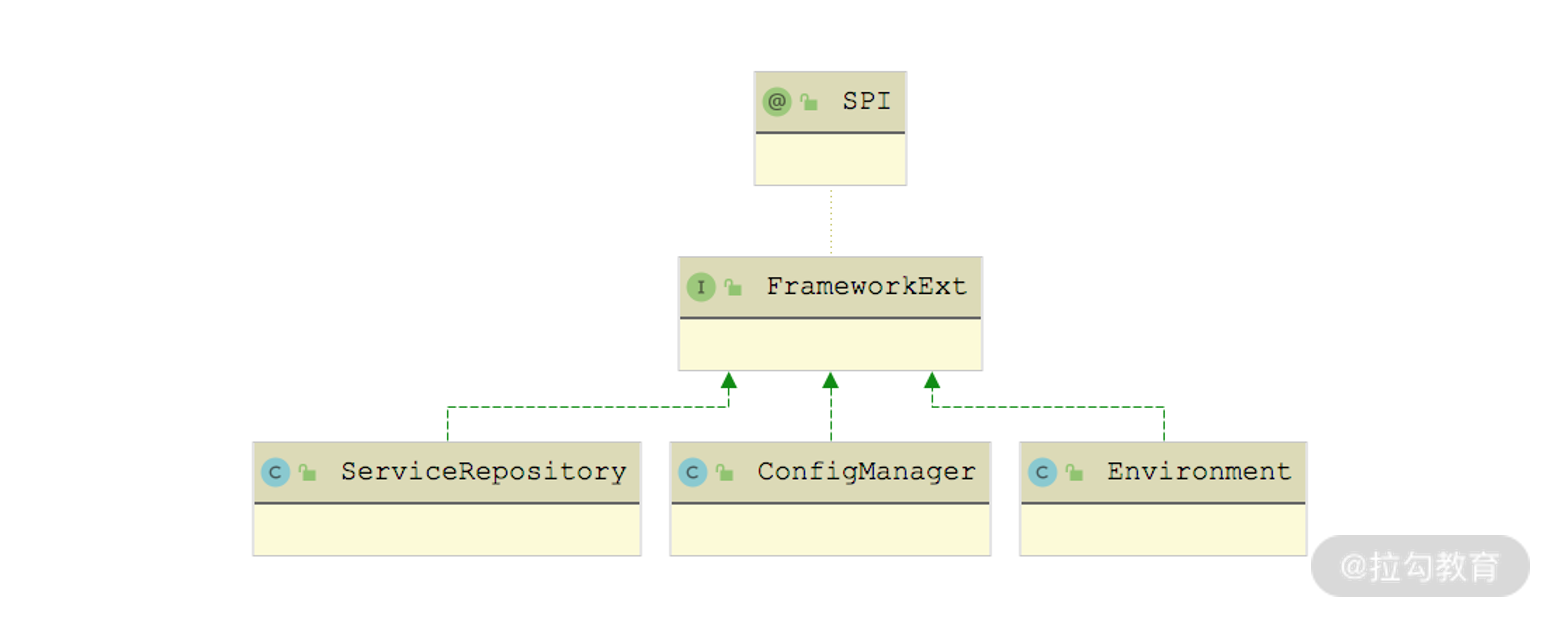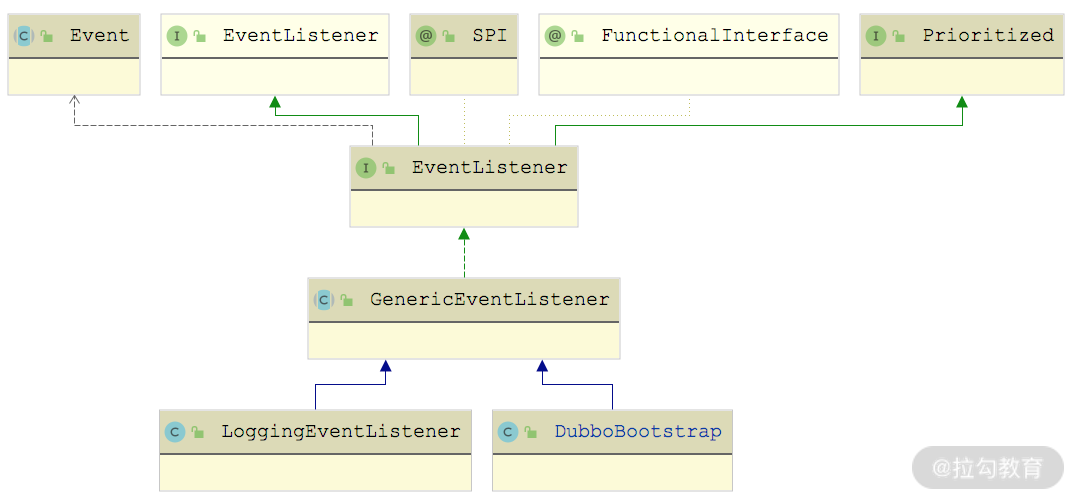48 配置中心设计与实现:集中化配置 and 本地化配置,我都要(下) 在上一课时,我们详细分析了 Configuration 接口以及 DynamicConfiguration 接口的实现,其中 DynamicConfiguration 接口实现是动态配置中心的基础。那 Dubbo 中的动态配置中心是如何启动的呢?我们将在本课时详细介绍。
基础配置类
在 DubboBootstrap 初始化的过程中,会调用 ApplicationModel.initFrameworkExts() 方法初始化所有 FrameworkExt 接口实现,继承关系如下图所示:

FrameworkExt 继承关系图
相关代码片段如下:
public static void initFrameworkExts() { Set
ConfigManager 用于管理当前 Dubbo 节点中全部 AbstractConfig 对象,其中就包括 ConfigCenterConfig 这个实现的对象,我们通过 XML、Annotation 或是 API 方式添加的配置中心的相关信息(例如,配置中心的地址、端口、协议等),会转换成 ConfigCenterConfig 对象。
在 Environment 中维护了上一课时介绍的多个 Configuration 对象,具体含义如下。
- propertiesConfiguration(PropertiesConfiguration 类型):全部 OrderedPropertiesProvider 实现提供的配置以及环境变量或是 -D 参数中指定配置文件的相关配置信息。
- systemConfiguration(SystemConfiguration 类型):-D 参数配置直接添加的配置信息。
- environmentConfiguration(EnvironmentConfiguration 类型):环境变量中直接添加的配置信息。
- externalConfiguration、appExternalConfiguration(InmemoryConfiguration 类型):使用 Spring 框架且将 include-spring-env 配置为 true 时,会自动从 Spring Environment 中读取配置。默认依次读取 key 为 dubbo.properties 和 application.dubbo.properties 到这里两个 InmemoryConfiguration 对象中。
- globalConfiguration(CompositeConfiguration 类型):用于组合上述各个配置来源。
- dynamicConfiguration(CompositeDynamicConfiguration 类型):用于组合当前全部的配置中心对应的 DynamicConfiguration。
- configCenterFirst(boolean 类型):用于标识配置中心的配置是否为最高优先级。
在 Environment 的构造方法中会初始化上述 Configuration 对象,在 initialize() 方法中会将从 Spring Environment 中读取到的配置填充到 externalConfiguration 以及 appExternalConfiguration 中。相关的实现片段如下:
public Environment() { // 创建上述Configuration对象 this.propertiesConfiguration = new PropertiesConfiguration(); this.systemConfiguration = new SystemConfiguration(); this.environmentConfiguration = new EnvironmentConfiguration(); this.externalConfiguration = new InmemoryConfiguration(); this.appExternalConfiguration = new InmemoryConfiguration(); } public void initialize() throws IllegalStateException { // 读取对应配置,填充上述Configuration对象 ConfigManager configManager = ApplicationModel.getConfigManager(); Optional<Collection
启动配置中心
完成了 Environment 的初始化之后,DubboBootstrap 接下来会调用 startConfigCenter() 方法启动一个或多个配置中心客户端,核心操作有两个:一个是调用 ConfigCenterConfig.refresh() 方法刷新配置中心的相关配置;另一个是通过 prepareEnvironment() 方法根据 ConfigCenterConfig 中的配置创建 DynamicConfiguration 对象。
private void startConfigCenter() { Collection
1. 刷新配置中心的配置
首先来看 ConfigCenterConfig.refresh() 方法,该方法会组合 Environment 对象中全部已初始化的 Configuration,然后遍历 ConfigCenterConfig 中全部字段的 setter 方法,并从 Environment 中获取对应字段的最终值。具体实现如下: public void refresh() { // 获取Environment对象 Environment env = ApplicationModel.getEnvironment(); // 将当前已初始化的所有Configuration合并返回 CompositeConfiguration compositeConfiguration = env.getPrefixedConfiguration(this); Method[] methods = getClass().getMethods(); for (Method method : methods) { if (MethodUtils.isSetter(method)) { // 获取ConfigCenterConfig中各个字段的setter方法 // 根据配置中心的相关配置以及Environment中的各个Configuration,获取该字段的最终值 String value = StringUtils.trim(compositeConfiguration.getString(extractPropertyName(getClass(), method))); // 调用setter方法更新ConfigCenterConfig的相应字段 if (StringUtils.isNotEmpty(value) && ClassUtils.isTypeMatch(method.getParameterTypes()[0], value)) { method.invoke(this, ClassUtils.convertPrimitive(method.getParameterTypes()[0], value)); } } else if (isParametersSetter(method)) { // 设置parameters字段,与设置其他字段的逻辑基本类似,但是实现有所不同 String value = StringUtils.trim(compositeConfiguration.getString(extractPropertyName(getClass(), method))); if (StringUtils.isNotEmpty(value)) { // 获取当前已有的parameters字段 Map<String, String> map = invokeGetParameters(getClass(), this); map = map == null ? new HashMap<>() : map; // 覆盖parameters集合 map.putAll(convert(StringUtils.parseParameters(value), “”)); // 设置parameters字段 invokeSetParameters(getClass(), this, map); } } } }
这里我们关注一下 Environment.getPrefixedConfiguration() 方法,该方法会将 Environment 中已有的 Configuration 对象以及当前的 ConfigCenterConfig 按照顺序合并,得到一个 CompositeConfiguration 对象,用于确定配置中心的最终配置信息。具体实现如下:
public synchronized CompositeConfiguration getPrefixedConfiguration(AbstractConfig config) { // 创建CompositeConfiguration对象,这里的prefix和id是根据ConfigCenterConfig确定的 CompositeConfiguration prefixedConfiguration = new CompositeConfiguration(config.getPrefix(), config.getId()); // 将ConfigCenterConfig封装成ConfigConfigurationAdapter Configuration configuration = new ConfigConfigurationAdapter(config); if (this.isConfigCenterFirst()) { // 根据配置确定ConfigCenterConfig配置的位置 // The sequence would be: SystemConfiguration -> AppExternalConfiguration -> ExternalConfiguration -> AbstractConfig -> PropertiesConfiguration // 按序组合已有Configuration对象以及ConfigCenterConfig prefixedConfiguration.addConfiguration(systemConfiguration); prefixedConfiguration.addConfiguration(environmentConfiguration); prefixedConfiguration.addConfiguration(appExternalConfiguration); prefixedConfiguration.addConfiguration(externalConfiguration); prefixedConfiguration.addConfiguration(configuration); prefixedConfiguration.addConfiguration(propertiesConfiguration); } else { // 配置优先级如下:SystemConfiguration -> AbstractConfig -> AppExternalConfiguration -> ExternalConfiguration -> PropertiesConfiguration prefixedConfiguration.addConfiguration(systemConfiguration); prefixedConfiguration.addConfiguration(environmentConfiguration); prefixedConfiguration.addConfiguration(configuration); prefixedConfiguration.addConfiguration(appExternalConfiguration); prefixedConfiguration.addConfiguration(externalConfiguration); prefixedConfiguration.addConfiguration(propertiesConfiguration); } return prefixedConfiguration; }
2. 创建 DynamicConfiguration 对象
通过 ConfigCenterConfig.refresh() 方法确定了所有配置中心的最终配置之后,接下来就会对每个配置中心执行 prepareEnvironment() 方法,得到对应的 DynamicConfiguration 对象。具体实现如下: private DynamicConfiguration prepareEnvironment(ConfigCenterConfig configCenter) { if (configCenter.isValid()) { // 检查ConfigCenterConfig是否合法 if (!configCenter.checkOrUpdateInited()) { return null; // 检查ConfigCenterConfig是否已初始化,这里不能重复初始化 } // 根据ConfigCenterConfig中的各个字段,拼接出配置中心的URL,创建对应的DynamicConfiguration对象 DynamicConfiguration dynamicConfiguration = getDynamicConfiguration(configCenter.toUrl()); // 从配置中心获取externalConfiguration和appExternalConfiguration,并进行覆盖 String configContent = dynamicConfiguration.getProperties(configCenter.getConfigFile(), configCenter.getGroup()); String appGroup = getApplication().getName(); String appConfigContent = null; if (isNotEmpty(appGroup)) { appConfigContent = dynamicConfiguration.getProperties (isNotEmpty(configCenter.getAppConfigFile()) ? configCenter.getAppConfigFile() : configCenter.getConfigFile(), appGroup ); } try { // 更新Environment environment.setConfigCenterFirst(configCenter.isHighestPriority()); environment.updateExternalConfigurationMap(parseProperties(configContent)); environment.updateAppExternalConfigurationMap(parseProperties(appConfigContent)); } catch (IOException e) { throw new IllegalStateException(“Failed to parse configurations from Config Center.”, e); } return dynamicConfiguration; // 返回通过该ConfigCenterConfig创建的DynamicConfiguration对象 } return null; }
完成 DynamicConfiguration 的创建之后,DubboBootstrap 会将多个配置中心对应的 DynamicConfiguration 对象封装成一个 CompositeDynamicConfiguration 对象,并记录到 Environment.dynamicConfiguration 字段中,等待后续使用。另外,还会调用全部 AbstractConfig 的 refresh() 方法(即根据最新的配置更新各个 AbstractConfig 对象的字段)。这些逻辑都在 DubboBootstrap.startConfigCenter() 方法中,前面已经展示过了,这里不再重复。
配置中心初始化的后续流程
完成明确指定的配置中心初始化之后,DubboBootstrap 接下来会执行 useRegistryAsConfigCenterIfNecessary() 方法,检测当前 Dubbo 是否要将注册中心也作为一个配置中心使用(常见的注册中心,都可以直接作为配置中心使用,这样可以降低运维成本)。 private void useRegistryAsConfigCenterIfNecessary() { if (environment.getDynamicConfiguration().isPresent()) { return; // 如果当前配置中心已经初始化完成,则不会将注册中心作为配置中心 } if (CollectionUtils.isNotEmpty(configManager.getConfigCenters())) { return; // 明确指定了配置中心的配置,哪怕配置中心初始化失败,也不会将注册中心作为配置中心 } // 从ConfigManager中获取注册中心的配置(即RegistryConfig),并转换成配置中心的配置(即ConfigCenterConfig) configManager.getDefaultRegistries().stream() .filter(registryConfig -> registryConfig.getUseAsConfigCenter() == null || registryConfig.getUseAsConfigCenter()) .forEach(registryConfig -> { String protocol = registryConfig.getProtocol(); String id = “config-center-“ + protocol + “-“ + registryConfig.getPort(); ConfigCenterConfig cc = new ConfigCenterConfig(); cc.setId(id); if (cc.getParameters() == null) { cc.setParameters(new HashMap<>()); } if (registryConfig.getParameters() != null) { cc.getParameters().putAll(registryConfig.getParameters()); } cc.getParameters().put(CLIENT_KEY, registryConfig.getClient()); cc.setProtocol(registryConfig.getProtocol()); cc.setPort(registryConfig.getPort()); cc.setAddress(registryConfig.getAddress()); cc.setNamespace(registryConfig.getGroup()); cc.setUsername(registryConfig.getUsername()); cc.setPassword(registryConfig.getPassword()); if (registryConfig.getTimeout() != null) { cc.setTimeout(registryConfig.getTimeout().longValue()); } cc.setHighestPriority(false); // 这里优先级较低 configManager.addConfigCenter(cc); }); startConfigCenter(); // 重新调用startConfigCenter()方法,初始化配置中心 }
完成配置中心的初始化之后,后续需要 DynamicConfiguration 的地方直接从 Environment 中获取即可,例如,DynamicConfigurationServiceNameMapping 就是依赖 DynamicConfiguration 实现 Service ID 与 Service Name 映射的管理。
接下来,DubboBootstrap 执行 loadRemoteConfigs() 方法,根据前文更新后的 externalConfigurationMap 和 appExternalConfigurationMap 配置信息,确定是否配置了额外的注册中心或 Protocol,如果有,则在此处转换成 RegistryConfig 和 ProtocolConfig,并记录到 ConfigManager 中,等待后续逻辑使用。
随后,DubboBootstrap 执行 checkGlobalConfigs() 方法完成 ProviderConfig、ConsumerConfig、MetadataReportConfig 等一系列 AbstractConfig 的检查和初始化,具体实现比较简单,这里就不再展示。
再紧接着,DubboBootstrap 会通过 initMetadataService() 方法初始化 MetadataReport、MetadataReportInstance 以及 MetadataService、MetadataServiceExporter,这些元数据相关的组件在前面的课时中已经深入分析过了,这里的初始化过程并不复杂,你若感兴趣的话可以参考源码进行学习。
在 DubboBootstrap 初始化的最后,会调用 initEventListener() 方法将 DubboBootstrap 作为 EventListener 监听器添加到 EventDispatcher 中。DubboBootstrap 继承了 GenericEventListener 抽象类,如下图所示:

EventListener 继承关系图
GenericEventListener 是一个泛型监听器,它可以让子类监听任意关心的 Event 事件,只需定义相关的 onEvent() 方法即可。在 GenericEventListener 中维护了一个 handleEventMethods 集合,其中 Key 是 Event 的子类,即监听器关心的事件,Value 是处理该类型 Event 的相应 onEvent() 方法。
在 GenericEventListener 的构造方法中,通过反射将当前 GenericEventListener 实现的全部 onEvent() 方法都查找出来,并记录到 handleEventMethods 字段中。具体查找逻辑在 findHandleEventMethods() 方法中实现:
private Map<Class<?>, Set
在 GenericEventListener 的 onEvent() 方法中,会根据收到的 Event 事件的具体类型,从 handleEventMethods 集合中找到相应的 onEvent() 方法进行调用,如下所示:
public final void onEvent(Event event) { // 获取Event的实际类型 Class<?> eventClass = event.getClass(); // 根据Event的类型获取对应的onEvent()方法并调用 handleEventMethods.getOrDefault(eventClass, emptySet()).forEach(method -> { ThrowableConsumer.execute(method, m -> { m.invoke(this, event); }); }); }
我们可以查看 DubboBootstrap 的所有方法,目前并没有发现符合 isHandleEventMethod() 条件的方法。但在 GenericEventListener 的另一个实现—— LoggingEventListener 中,可以看到多个符合 isHandleEventMethod() 条件的方法(如下图所示),在这些 onEvent() 方法重载中会输出 INFO 日志。

LoggingEventListener 中 onEvent 方法重载
至此,DubboBootstrap 整个初始化过程,以及该过程中与配置中心相关的逻辑就介绍完了。
总结
本课时我们重点介绍了 Dubbo 动态配置中心启动的核心流程,以及该流程涉及的重要组件类。
首先,我们介绍了 ConfigManager 和 Environment 这两个非常基础的配置类;然后又讲解了 DubboBootstrap 初始化动态配置中心的核心流程,以及动态配置中心启动的流程;最后,还分析了 GenericEventListener 监听器的相关内容。
关于这部分的内容,如果你有什么问题或者好的经验,欢迎你在留言区和我分享。
参考资料
https://learn.lianglianglee.com/%e4%b8%93%e6%a0%8f/Dubbo%e6%ba%90%e7%a0%81%e8%a7%a3%e8%af%bb%e4%b8%8e%e5%ae%9e%e6%88%98-%e5%ae%8c/48%20%20%e9%85%8d%e7%bd%ae%e4%b8%ad%e5%bf%83%e8%ae%be%e8%ae%a1%e4%b8%8e%e5%ae%9e%e7%8e%b0%ef%bc%9a%e9%9b%86%e4%b8%ad%e5%8c%96%e9%85%8d%e7%bd%ae%20and%20%e6%9c%ac%e5%9c%b0%e5%8c%96%e9%85%8d%e7%bd%ae%ef%bc%8c%e6%88%91%e9%83%bd%e8%a6%81%ef%bc%88%e4%b8%8b%ef%bc%89.md
更多学习
更多实时资讯,前沿技术,生活趣事。尽在【老马啸西风】
交流社群:[交流群信息](https://mp.weixin.qq.com/s/rkSvXxiiLGjl3S-ZOZCr0Q)
